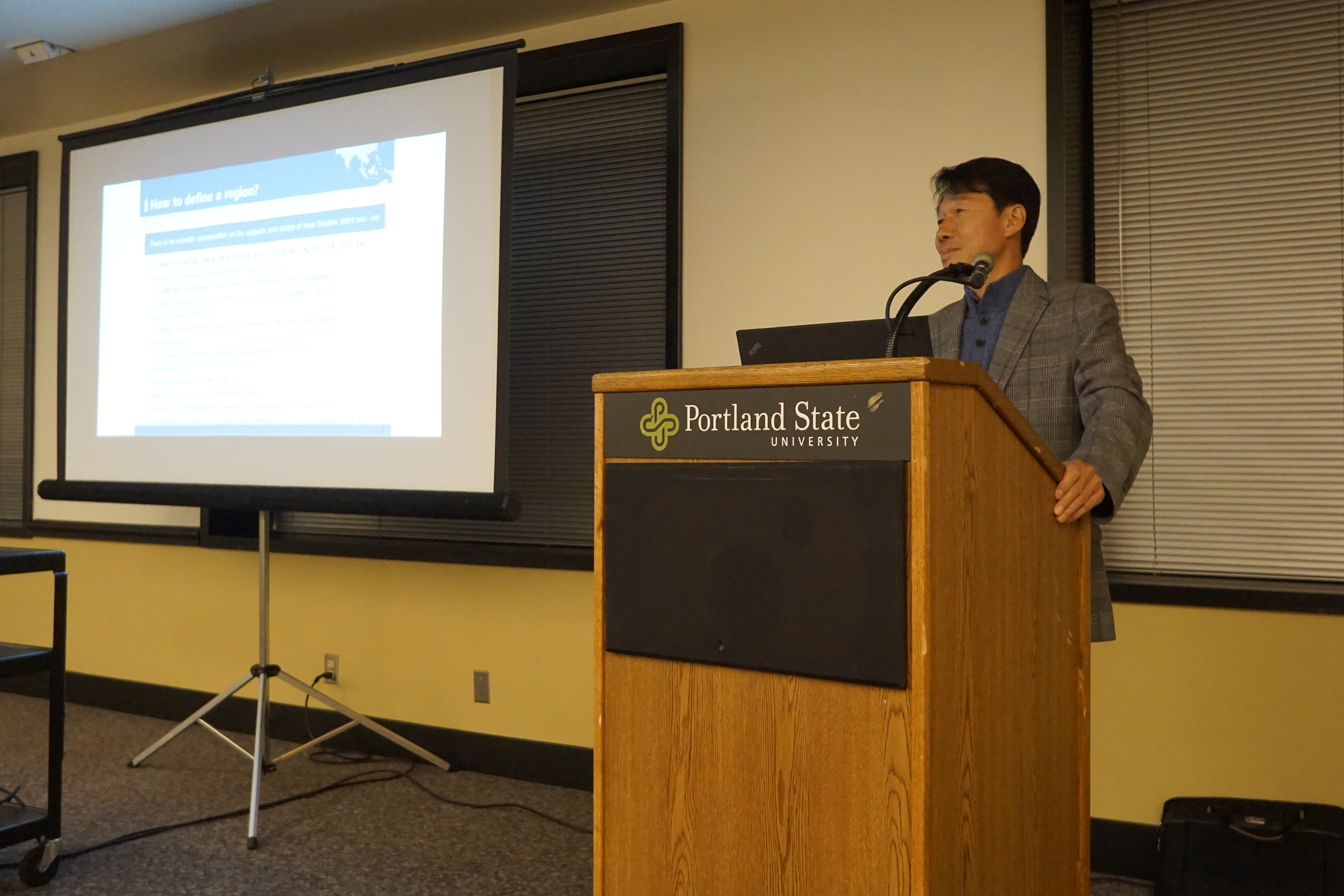On Dec. 1, as part of the Institute for Asian Studies’ ongoing Visiting Scholar Lecture Series, Dr. Chanwahn Kim, professor of Indian and ASEAN Studies at the Graduate School of International and Area Studies, Hankuk University of Foreign Studies, South Korea, presented a talk on the North Bay of Bengal as a sub-region. He discussed the region’s growing importance as a market and as an arena where the two most populous countries in the world, India and China, are competing for influence.
Bordered by India and Sri Lanka to the west, Myanmar to the east, and Bangladesh to the north, the Bay of Bengal is the largest bay in the world. Kim has been making his case for the North Bay of Bengal as a sub-region over the last few years at international conferences and in his published work. He acknowledged that defining the boundaries of regions and sub-regions, like defining any border, is often anything but straightforward.
“Very often we discuss regions: Asia, Europe, North America, South America, Latin America, South Asia,” Kim said. “Suppose we are discussing East Asia. East Asia starts from where?”
He went on to present the East Asia Summit as an example of how political considerations can override geographical, cultural, or historical concerns when determining how to define a region.
The East Asia Summit began in 2005 as an annual forum held after the Association of Southeast Nations leaders’ meetings.
“India claimed it was part of East Asia,” Kim explained, “So China says, ‘Who says so? You aren’t part of East Asia, you’re part of South Asia.'”
India eventually overcame Chinese objections to its inclusion, due in no small part to support from other member nations. As Singapore’s Prime Minister at the time Lee Kuan Yew observed, the hope was that India would help to offset China’s outsized influence:
“We agreed that we should also invite India, Australia, and New Zealand, and keep the center in ASEAN; also, India would be a useful balance to China’s heft,” Kim said.
Kim argued that the North Bay of Bengal serves as an important focal point for the jockeying of position of these two giants. In addition, aside from geography, Bangladesh, Myanmar, and northeastern India also share a cultural, historical, and ecological lineage that make the area worthy of study as a single sub-region.
Why is this region so important? For one, its location as a nexus between mainland China, India, and southeast Asia means it is a vital link in any economic corridor between the three large markets surrounding it. The sub-region is also emerging as its own market, with international organizations such as the Bay of Bengal Initiative for Multi-Sectoral Technical and Economic Cooperation working to promote technological and economic cooperation between the nations along the Bay of Bengal. Recent discoveries of natural gas reserves also could increase the strategic and economic importance of the area.
According to Kim, many of India’s policy decisions in the region can be seen as a reaction to China’s growing presence in a part of the world that has long been considered part of India’s sphere of influence.
In 2013, Chinese Premier Xi Jinping unveiled the country’s new One Belt, One Road development policy, which proposed trade routes and infrastructure connecting mainland China with Eurasia, “the belt,” along with a maritime “silk road” connecting China with southern Asia and northeastern Africa.
The following year Indian Prime Minister Narendra Modi launched the government’s Make in India initiative, which encouraged international companies to manufacture their goods in India, and which contributed to India’s surpassing of China as the top destination for foreign direct investment in 2015.
Kim pointed to India’s recent historic land deal with Bangladesh as part of its commitment to the North Bay of Bengal as a vital region for economic development.
“You know, in modern society the most difficult problem to solve, from the government’s point [of view], is a land dispute,” Kim said. “No country is ready to sacrifice a single inch of land to another country. But India sacrificed; they handed over huge amounts of land to Bangladesh in order to promote further development.”
In addition to the establishment of commercial ports and naval bases, Kim points out that China is making overtures to countries in the area that have traditionally had a unique relationship with India.
“China not only developed naval base, but also they now invest a lot of money around North Bay of Bengal,” Kim said. “In 2013 China became the single most important investor in Nepal. Traditionally, India and Nepal have had a unique relationship.”
Although there are several strategies at India’s disposal to contend with these developments, there is a central dilemma. The northeastern region of India, historically ignored by the central government, now finds itself being courted by Chinese developers. India can’t develop this region without Chinese assistance, which would allow them to establish a greater presence in the area. However, if they continue to ignore the area as they have in the past, then Chinese influence may make its way into the region anyway. Kim remarked that during his visit to the region, he noticed that most of the consumer goods available for purchase were manufactured in China, entering the country by way of Myanmar.
From the development point of view, this competition is good for the people in the North Bay of Bengal, as they are getting investment and attention from both China and India as the two nations compete for influence in the region. On the downside, this extension of economic influence is also accompanied by an increased military buildup to protect economic interests. Long ongoing military exercises by India and the U.S. in the Bay of Bengal have expanded in recent years, with the inclusion of Japan as a permanent partner starting last year.
At the last talk organized by the Institute for Asian Studies, Dr. Karl Gerth, professor of History and Hsiu Chair in Chinese Studies at the University of California, San Diego, postulated that many of China’s policy decisions could be viewed through the lens of its transition toward a consumer-driven economy. When asked about how India plans to go about reconciling the same kind of environmental and economic contradictions China is facing, Kim pointed out that India’s industrial sector is far behind China’s, and while many of his friends in India complain about the worsening environmental conditions brought on by industrialization and development, for countless other Indians, worrying about the whether the global temperature rises to over two degrees Celsius above historical norms isn’t a luxury they have.
“When you feel hungry, first you worry about bread, then you worry about air.”







Kolkata or Dhaka will be the future epicenter of this BIMSTEC region along with ASEAN after Singapore.
This huge water body will be a key to economic movement with all growing emerging nations together – China, India, Indonesia, Malaysia, Vietnam, Bangladesh..